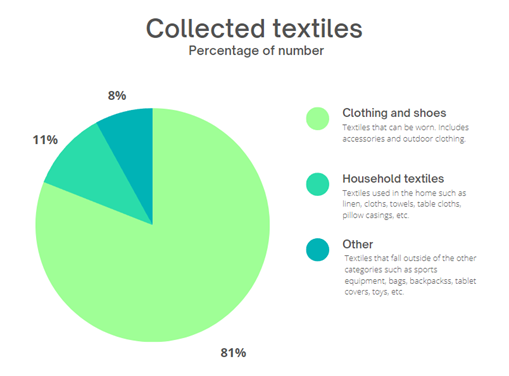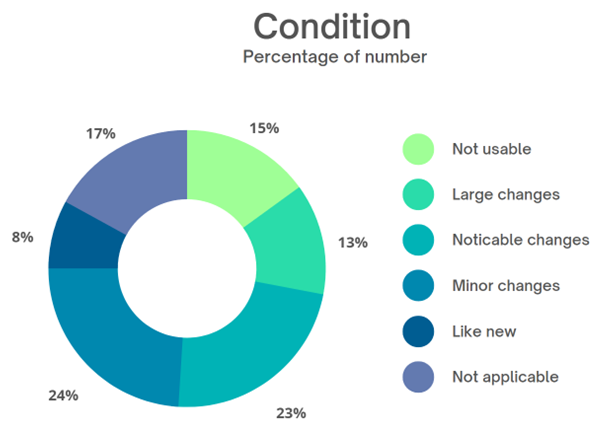Wardrobe study of clothing and other textiles going out of use from Norwegian households
Author: Anna Schytte Sigaard, PhD Student, Consumption Research Norway (SIFO), Oslo Metropolitan University.
Aims and objectives
The wardrobe studies method has been a central part of my PhD project entitled “Want Not, Waste Not: A wardrobe study approach to minimizing textile waste from Norwegian households”. The aim of the project is to create knowledge about the disposal part of the consumption phase of textiles in Norwegian households by collecting and analyzing textiles going out of use to find out how and why people get rid of clothing and other textiles and what they get rid of. A comprehensive mapping of disposed textiles has been carried out to gain knowledge about the technical composition and history of the individual textile. The topic has been explored through the following research questions:
- What do discarded textiles from Norwegian households consist of?
- How and why are textiles disposed of from the households?
- What value do people attach to their used textiles, and how does this affect disposal?
The theoretical framework is based on practice theory which has been used as a point of departure for carrying out wardrobe studies as a research method, and for understanding and analyzing data from fieldwork.
Context
The issue of textile disposal holds significant environmental implications, as waste creation poses a major challenge within the textile and clothing industry. Existing perspectives commonly attribute waste creation to production inefficiencies or place responsibility solely on the consumer. However, these perspectives fail to acknowledge the interconnectedness of the various processes and practices that constitute everyday life. Disposal should not be regarded as an undesirable byproduct, but rather as a crucial and integral part of the consumption process, encompassing social, ethical, and performative aspects. In the context of textiles, understanding consumers’ disposal behavior becomes essential, as they hold the power to determine how and when textiles are discarded. This directly impacts the lifespan of textiles, the amount of waste generated, as well as the potential for reuse and recycling. In my project, disposal refers to the act of getting rid of something regardless of whether it is discarded as waste, delivered to recycling, donated to clothing collectors, given to friends or family, etc. An important contribution of this project is to deepen the understanding of an important, yet neglected area of consumption research, namely why we get rid of the things we no longer want.
Method
The data material in this project consists of wardrobe interviews, fieldnotes and textile registrations. In total, 82 interviews were carried out with 28 households from three parts of Norway: Oslo (11), Vestfold (9) and Salten (8). A total of 73 people of different ages participated in the project. The households were recruited strategically with the intention of obtaining a diverse group of participants to cover as wide a range of perspectives as possible. Therefore, participants of different ages and genders living in both urban and rural areas have been included as well as different types of dwellings. Residing in a bigger or smaller residence affects how much can be stored which may decrease or increase the number of textiles leaving the household. Data collection was carried out during one year starting from October 2021 and ending in October 2022 and comprised a six month participation period for each participant.
A start-up interview lasting maximum one hour was carried out with each household at the beginning of the participation period. The following six months, participants collected all textile items that would have otherwise left the households. Textile items included everything made of fabric such as clothing and shoes, household textiles such as linen, towels, cloths, and equipment such as bags, packaging, and toys. Larger furniture and textile installations, such as fixed carpets, were excluded. After three and six months, at-home wardrobe studies interviews were carried out. The duration of these interviews depended on how much had been collected by the participants and lasted anywhere between 20 minutes and up to three hours. Interviews were centered around the textile items collected by the participants and usually took place in the living room, kitchen, or on the porch in the participants home. We would look at, touch, and sometimes smell each item individually and lay them out on a table or the ground in front of us while the participants answered questions about how long they had had the item, how much they had used it, how they had used it, if they had made any repairs or alterations, how they acquired it, and why they were disposing of it.
A total of 3556 pieces were collected. The textile items were tagged with a letter reference to the household it came from and number (for example A1, A2, A3 etc.) during the interviews in the order in which they were brought up by the participant. After the interview, all textile items were brought back for analysis and information about each piece was registered in Excel together with information from the interviews. The following information was registered for each piece individually (when available): type of textile, weight, brand, color, print, fiber content, number of fibers, construction, recommended wash temperature, ecolabelling, general condition, holes, broken seam, color change, shrinkage/shape change, pilling, felting, and repairs/alterations. In addition, each textile item was photographed after registration.
Stories from wardrobe interviews
Wardrobe interviews were based on what the participants had collected and differed therefore in length as well as content. Below are three examples from interviews of how centering the conversation around the physical items provide meaningful and interesting narratives and insights. Quotes have been translated from Norwegian.
Maria, 38
Item: kitchen towel and microfiber cloth (see image)
“I can’t get rid of the smell on them. This is an old kitchen towel from my grandmother. I took it when she passed away 15 years ago but it has become a little worn. I have used it a lot before, but I got some new ones for Christmas. [The cloth] doesn’t work so well anymore. It doesn’t absorb anything. I have had it a long time, probably for many years, so it’s old. I have used it quite a bit. Now I just want to get rid of it. It smells!”
Maria insisted that I did not bring the cloth back with me for registrations since it was so dirty and smelly. Instead, she threw it into the bin in her kitchen before we continued the interview.

Freda, 65
Item: sweatpants
“And then the cozy pants go. They have been used quite a bit, but I hate them. I think it’s absolutely terrible to walk around in them and I just don’t want them anymore. I broke my back 13 years ago and I had problems moving and putting on clothes so I asked my husband to go buy a pair of sweatpants because I didn’t have any, I’m not a sweatpants person, but I had to have something that I could just pull up, so he bought them for me. It’s nice to wear something like that to relax, so I have used it but not that much. It has been [visibly] washed and used after all. They were bought for medical reasons and I’m getting rid of them for medical reasons. I have to have pants where I can feel if I’m getting fat and you don’t in those kinds.”
Kasper, 33
Item: pants
“They are all worn out. You can almost see through them, so I’m not allowed to use them anymore. They have simply expired. And they have also ripped in the bottom. I have used them a lot, I managed to use them for at least two years, but they have been lying around for a while now. But I used them almost daily. They are very comfortable. I have really worn it to pieces. It was my gaming pants so it has been sat in a lot. I also used it for working out in the beginning. That was okay as well, just a little warm.»
Results
The project is still ongoing, but some preliminary results based on the quantitative data material have already been identified:
- Most of the collected textiles were clothing and shoes (see graph below).
- The largest category of collected clothing in percentage of number was children’s clothing followed by sock. When looking at percentage of weight, however, the largest category was bottoms (jeans, shorts, skirts etc.) and thin tops.
- Almost a third (32%) of the collected were in very good condition (like new or with only minor changes) (see graph).
- The most common damage was pilling followed by holes, color change, stains and shrinkage. The least common were broken seams and broken parts.
More results are available in the report “Want not, waste not: Preliminary findings” (see link below). Moving forward, the qualitative interview data will be analyzed. I will be looking into why clothing and textiles that are not broken or damages have been disposed of by focusing on the practices were consumption of clothing and textiles form an integral part.


Insights
The contribution of wardrobe studies in the effort to minimize textile waste, is to create an understanding of the relationship between the individual textile item and the larger material context. As it includes the technical characteristics of the textiles along with knowledge about the owner’s social life including the practices involved, the method creates an understanding with a specific focus on the material element of social practices. In this way, it deals with the interconnectedness between how something is talked about and the material item itself. The purpose of including the physical element into the interview situation is to tap into the participants’ sensory relationship with the items. The aim of having participants engage physically with the items was to elicit memories about acquisition and use through the sensory elements which is difficult to obtain through the typical conversational interviews.
Publications from project
Sigaard, A. S. (2023). Want Not, Waste Not: Preliminary findings. Retrieve here.
Sigaard, A. S., & Laitala, K. (2023). Natural and sustainable? Consumers’ textile fiber preferences. Fibers, 11(2). Retrieve here.